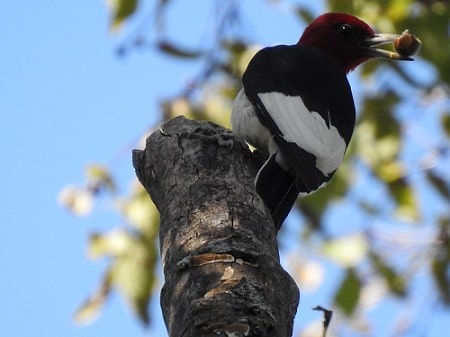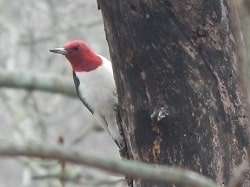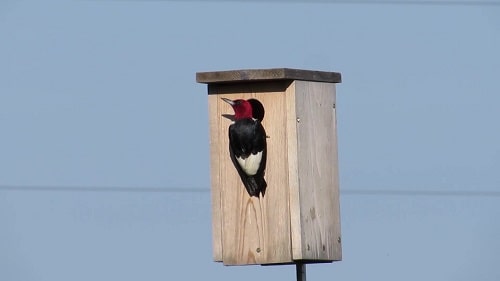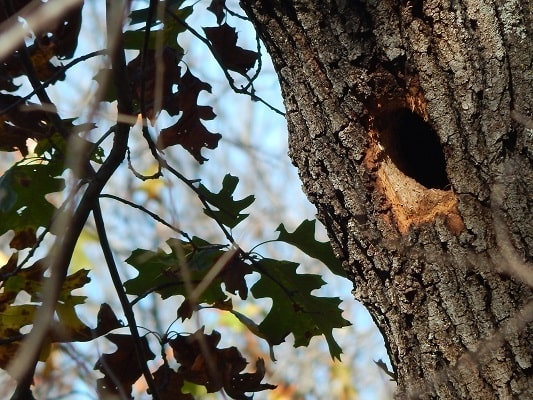Red-headed Woodpecker: Identification, Nesting & Diet
The Red-headed Woodpecker is one of the most eye-catching birds in North America, renowned for its vivid crimson head, glossy black back, and gleaming white wings.
This bold pattern makes it nearly impossible to confuse with any other woodpecker.
They are strikingly visible and often first noticed by their harsh calls rather than their drumming.
Though still widespread, they've declined across much of their range due to habitat loss, competition for nest sites, and the removal of standing dead trees they depend on for nesting.
Once seen up close, they're easily distinguished from the Red-bellied Woodpecker, which shows only a reddish crown and a barred back.
Description: Size and Field Marks

Red-headed Woodpeckers measure 8.5 to 9.5 inches long with a wingspan of around 16 inches.
They are the only North American woodpecker species with an entirely red head.
Their plumage forms clean black-and-white color blocks: bright white underparts and wing patches contrasting sharply with black upperparts.
Females and males look similar. Juveniles have brown heads with black backs and white wing patches until they molt into adult colors.
Similar species: The Red-bellied Woodpecker has a barred back and partial red crown.
The entirely red head of this species and its distinct color contrast make identification easy from a distance.
Listen to the Red-headed Woodpecker Call
These birds inhabit open woods, groves, farmland, and suburbs. They're most common in regions east of the Rockies where old trees remain.
Their vocalizations carry well, which I find helpful in spotting them.
Feeding Habits
Red-headed Woodpeckers are highly adaptable omnivores. Their diet includes insects, acorns, fruits, nuts, seeds, and occasionally small vertebrates.
They are skilled at catching insects in midair and foraging on trees or on the ground.
You can attract them with suet, black-oil sunflower seeds, and shelled nuts such as peanuts.
They cache food, especially acorns and insects, in tree bark and defend these stores from other woodpeckers, jays, and crows.

Where They Live
Red-headed Woodpeckers favor open woodlands, parks, and farmlands with scattered trees. They often choose areas with large dead limbs or standing snags for nesting.
These dead trees are critical for life. Unfortunately, they are often removed for firewood or safety, reducing available habitat.
Loss of open forest and competition for cavities from European Starlings also affect their numbers.
Urban development continues to shrink suitable areas.
Leaving dead trees or installing woodpecker houses supports nesting opportunities in urban and rural areas alike.

Mating Habits and Breeding Season
Breeding begins in late April in most areas, earlier in the southern range.
Males advertise territories with calls and flight displays rather than extensive drumming.
Pairs are typically monogamous for a single season but may reunite in subsequent years if both return to the same site.
Once bonded, they work together to excavate cavities in dead trees or limbs.
Birds breeding early in the season sometimes manage a second brood, though most raise only one per year.
Unlike many species, Red-headed Woodpeckers sometimes reuse old nest sites if the cavity remains sound.
Egg Laying and Nesting Habits
Both adults excavate the nest, with the male often taking the lead.
Cavity construction may last one to three weeks depending on tree hardness and weather.
Nest cavities are usually 8 - 14 inches deep, though some may reach 18 - 24 inches in softer or larger snags.
They can occur anywhere from a few feet to over 65 feet above the ground.
Egg laying may begin as early as late April and continue into July. The eggs are glossy white, with an average clutch of about five, ranging from three to ten.
Both parents share incubation, lasting about 12 - 14 days.
After hatching, the young fledge in about 25 - 30 days and may remain near their parents for several weeks before dispersing.
| Breeding and Nesting Timeline | |
|---|---|
| Breeding Season | Late April through July |
| Eggs | 4 - 7 |
| Incubation | 12 - 14 days |
| Nestling Phase | 30 days |
| Broods | 1 rarely 2 |

Migration
Migration varies from year to year. Northern populations may move south in late fall when acorn crops fail, while southern birds usually remain year-round.
This behavior is called irruptive migration.
Warmer winters since the 2010s have allowed more individuals to overwinter farther north, particularly in the Midwest where oak woodlands and stored acorns sustain them.
Range and Conservation
The Red-headed Woodpecker breeds across the central and eastern United States and southern Canada, from the Great Plains eastward.
Northern populations migrate, while southern populations remain resident.
Range loss and nest cavity competition from invasive European Starlings continue to pressure the species.
Long-term survey data from the U.S. Geological Survey show a population decline of over 60 percent since 1970.
The IUCN lists the species as Least Concern (2025), yet state-level assessments classify it as a Species of Greatest Conservation Need in many regions.
Protecting large snags, restoring open oak habitats, and reducing removal of dead trees are key to stabilizing populations.
With habitat management and nest box assistance, local numbers can rebound, ensuring this bird continues to brighten North American woodlands for generations to come.








